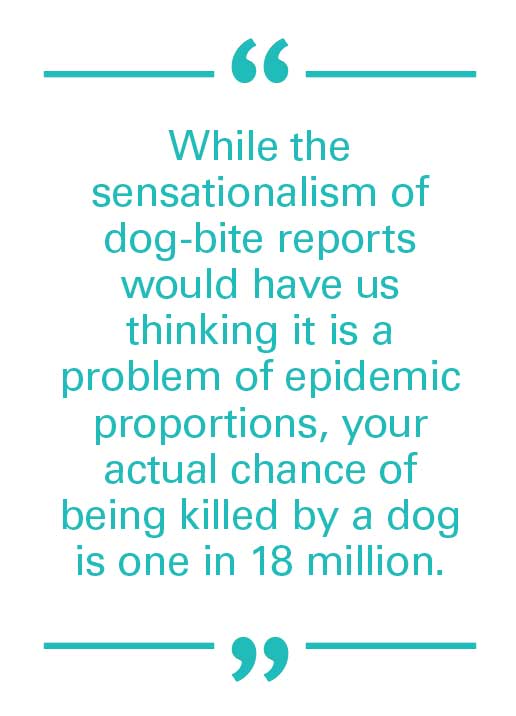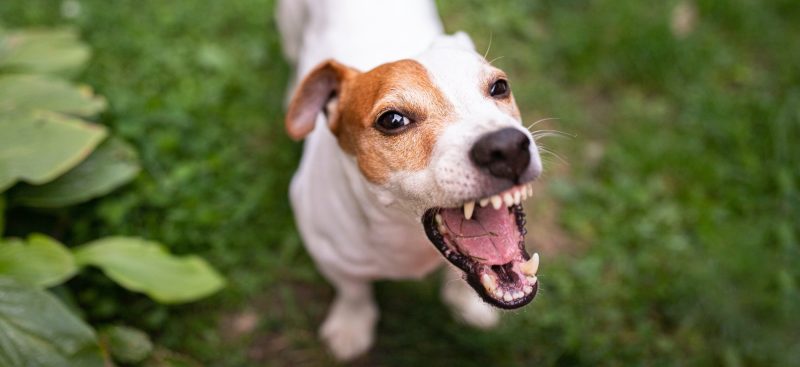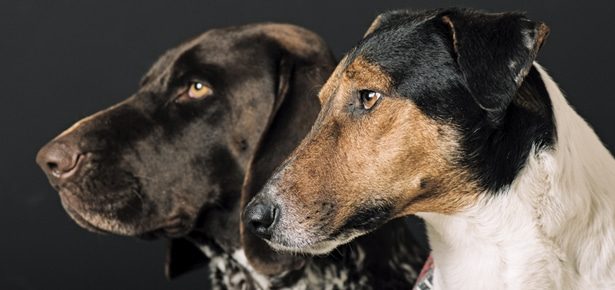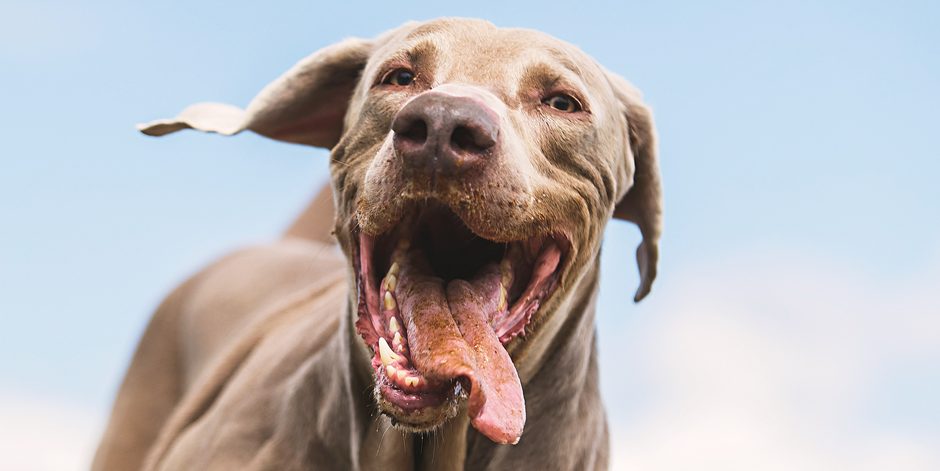

Preparing Your Dog for a Baby’s Arrival: How to Introduce Your Dog to a New Baby
A behaviourist-trainer-vet’s account of preparing her Pit Bull for an infant’s imminent arrival.
During a routine email exchange with my mom last month, six weeks before the due date of my first baby, the wise words of my dog training mentor rang loud and clear for the first time. Ian Dunbar had warned me: “Family and friends rarely see you as a real expert in your field when it comes to their personal lives—so don’t expect them to, and try not to take it personally.”
After an honours degree in psychology, over 15 years of experience as a dog trainer—ten of which include writing and public speaking for veterinary and dog training professionals—never mind a veterinary degree, the last line of my mother’s email was a shocker: “So what are your plans for re-homing Charlotte before Jake is born? Just wondering. Love Mom.”
Meet Charlotte:
Charlotte is my 11-year-old Pit Bull, whom I adopted as a young pup. She’s a delightful dog provided you are not of the canine species, and has been a wonderful companion. But in the presence of any unknown dog she is true to her breed: a major hassle for even the skilled handler and a frightening canine psychopath to the lay observer.

Predictably, Charlotte fights with any unfamiliar dog she meets but does no damage, and lives a life rich in human and cat company, and very light on doggie hobnobbing. Truth is, we basically avoid cold encounters with unknown dogs like the plague.
She meets babies and kids now and then, under the control of a head halter, and has never appeared fearful or aggressive towards them. But her body awareness is on par with BamBam from The Flintstones, which is to say, clumsy enough to knock over or scare a youngster. Between her typical bully overgregarious play style and our provincial breed-related legalities, I have mostly restricted her from meeting unknown children, especially toddlers who are inclined to grab feet and tails—not Charlotte’s favourite type of handling.
My family has always considered Charlotte to be a hindrance to me, requiring housesitter hassles instead of simple doggie daycare or kennel boarding, expensive fencing, and constant vigilance for dogs on the horizon. But they’ve treated her kindly over the years and respected my love and devotion to her nonetheless. That is, until I explained that there were no plans for relocation, that Charlotte was staying put in her home WITH my new baby, and that, despite her dog issues I do not consider her an undue risk to a newborn. That’s when things got a bit ugly.
In one fell swoop I went from professional dog trainer, writer, and veterinarian, worthy of boasting about to friends and family, to “a blindly biased, obstinate, irresponsible parent who will be very sorry that she let her pride put her baby’s life at risk.” Charlotte was instantly reclassified as a potential baby-killer, and no amount of fact-citing seemed to have an impact on their conviction.
Had I countered aggression with aggression, like some traditional dog-trainers might, the conflict would probably have spiralled even further downward. But the years of discipline in gentle behaviour modification taught me that fear-based aggression must not be corked; the cause needs to be identified and patiently remedied through confidence building.
I accepted the fact that my well-qualified risk assessment was wholly unconvincing to worried family, and offered to have “objective” input from world-renowned dog experts who happen to know Charlotte personally. Their reiteration that (1) dog-dog aggression is no predictor of dog-baby aggression, and (2) a well-socialized Pit Bull like Charlotte who shows no signs of concern over children poses no extraordinary risk compared to any other dog of similar size, was welcomed and seemed to carry some weight. As did my partner’s 30 years of experience as a veterinarian: he patiently debunked myths of locking Pit Bull jaws, clarified confusion between dog-dog scrappiness and dog-human aggression, insisted that any dog can become predatory towards young children without warning and that NO DOG is 100 percent safe with kids, and reassured them that of the hundreds of families he has counselled similarly over the years, none has reported any tragic consequences.

Janis Bradley’s book Dogs Bite but Umbrellas and Slippers are More Dangerous (2005; James and Kenneth), provides a wonderful review of the relative risk of dogs to people in the context of modern society. While the sensationalism of dog-bite reports would have us thinking it is a problem of epidemic proportions, your actual chance of being killed by a dog is one in 18 million: you are five times more likely to be killed by a bolt of lightning! The reality is that dogs don’t actually bite very often, when they do they seldom cause injury, and even when they injure it is very rarely serious. True, they pose a greater risk to children, who account for 10 of the 16 dog-related fatalities each year in the United States, but when compared to other rare causes of death in children it is a wonder dog bites even make the radar.
Prefer hard numbers? Toys, playground equipment, and five gallon buckets EACH kill more children annually than dogs, and none of these rank anywhere close to the 886 children a year killed by their own family. Comparing dog-bite fatalities to car accident statistics (45,000 deaths per year across ages) shows how absurd it is to fret about Fido when transporting baby around in an auto.
Bottom line is that dogs and kids are a pretty safe bet, and the very rare yet devastating fatal attacks that hit the media are almost exclusively committed by groups of dogs left unsupervised with young children. And there is absolutely no credible data suggesting that Pit Bulls are an exception.
Dogs and kids can be a golden combination with a plethora of health and social benefits, but they do require informed guardians who implement some basic precautions. After years of helping others prepare Fido and family for the new baby, it’s now my turn to walk the walk. Five golden rules sit under my fridge magnet as a daily reminder.
1 Plan for having less time with the dog after the baby is born and transition the dog to a “post birth” exercise/social regimen. Charlotte now has a pet nanny that exercises and feeds her, and will do for six months after Jake is born. Two friends whom she loves will also be spending extra social time with her.
2 Get the dog used to the sounds of babies and their toys. Charlotte has been enjoying chicken wieners to the musical (not!) sounds of crying babies, screaming toddlers, and any other child-related soundtracks I can find online.
3 Set up baby-free and dog-free spaces in the house. Dogs and young kids cannot be left unattended, so some zoning is needed. I’ve put up gates on both floors and Charlotte is getting used to being restricted from the dog-free sections. She’s growing quite fond of the baby-free zones where stuffed Kongs, fine bedding, and a belly-rubbing nanny have appeared.
4 Review the Pavlov Principle: plan how you will associate the new baby with something that rocks your dog’s world. Just like Pavlov’s dog learned to drool at the lunch bell, you want Fido to get warm and fuzzy over Baby. Jake’s first blanket will go home for Charlotte to sniff, and accompany her all-time favourite dinner: parmesan meatballs on spaghetti topped with liver powder. Yummm!
5 Plan the first meeting of baby and dog, setting everyone up for a successful first impression. We’ll make sure Charlotte has had lots of social time and been well exercised the day Jake comes home. I’ll greet Charlotte on my own first, to let her vent her enthusiasm, and then have someone else introduce Jake bum-first while I sweet-talk Charlotte and give her lots of goodies. She can safely lick Jake’s bottom—there’s nothing sterile about a baby bum—and we’ll keep the first encounter brief but positive.
Ten days from now, I’ll become a first-time mom, and I have nothing but great hopes for my dog and baby bonding well. Charlotte says she’s ready for “poop patrol” duty (a cookie each time you change baby’s poopy diaper quickly turns Fido into an ace poop patroller… salivating at your heels well before your nose could alert you), and my partner, mom, friends, and dog nanny are all coached and ready to help Charlotte adjust safely to our new lifestyle.
One Year Later
“Daa” is Jake’s only word so far. My partner Tim likes to think it means “dad,” but our stubby oneyear- old’s index finger pointed squarely at the dog says otherwise. Charlotte, our 12-year-old Pit Bull, has adapted well to her new name, along with the Neanderthal hugs, jocklike whacks, and obnoxious sounds emitted by her two-legged sibling. Admittedly, I’m longing to hear my son say “mama.” But for now I’ll settle for his monosyllabic reference to the big hairy beast that our relatives feared would harm him, the 80 pounds of terrier who is arguably his best friend.
Our comedic duo of Pit Bull and toddler have turned out to be real bosom buddies. A far cry from the tragedy forecast a year ago by worried relatives who were adamant that a dog-aggressive terrier and a newborn have no business living together. The concern was misguided, but very understandable. Charlotte is a big, strong dog of ill-reputed breed and a downright nuisance with other dogs. She is the classic backyard-bred Pit Bull: a sweetheart with humans and a social misfit with her own kind. But Charlotte’s lifetime track record of being exceptionally people-friendly, and her ability to scrap without doing any harm to even her worst canine foes, makes her as safe as any large dog can be around babies. Not an easy sell for a breed with entrenched mythology about locking jaws and “turning” on people, even for my partner and I, two veterinarians able to cite all the scientific facts and agreement of our expert colleagues. Despite some pretty pushy pleas to re-home her, Tim and I stuck to our guns and proceeded with the planning and work that is needed for any blended family of canine and kid. The training and safety considerations apply well beyond big burly terriers, so I’ll take the opportunity to share some pointers from our four step “tail” of success:
Step One: First Impressions
No sooner did I deliver Jake than we delivered home some of his used baby blankets. You only get one shot at making a great first impression, so Charlotte’s first whiff of Jake was followed immediately by a five-star dinner of meatball parmesan. The order and timing is important when teaching new associations. First you present the thing you want the dog to like (baby smell), then something fabulous just a split second after (dinner). Easy when you are working with blankets and a food bowl, more complicated when working with five pounds of squirming newborn. So for our arrival home we had two extra adults on hand and preassigned roles. Tim was baby-butt-presenter, I was dog handler, our pet nanny was baby gate manager and my mom was on stand-by for post-greeting handoff of baby Jake. Yes, it was tantamount to stage planning for a Broadway production; laugh if you will, but it worked. We kept their introduction short and sweet: once Charlotte had some good sniffs and a few chunks of freeze dried liver, we passed Jake off to my mom so we could fuss over the dog like she was queen of the castle. Charlotte seemed impressed with the new addition, and we were rather impressed with ourselves. Jake was impressed with no one, and did what newborn babies do best—kept us up most of the night!
Step Two: Build a Foundation of Trust between Siblings Prenatal class prepares you to respond to your baby’s cry like a world class butler, prompt and reliable. They do not prepare you for juggling TWO needy creatures that must learn to like each other. We knew that when Jake cried he could wait an extra few seconds to be tended to, so we made sure we tossed something good Charlotte’s way en route. It didn’t take her long to go from tucking her tail to salivating when Jake wailed. And with four adults around there was usually enough manpower to give Charlotte some love and attention along with her snack. Charlotte adjusted very quickly to cries from a distance, but erratic movements and sudden screams in close proximity took a bit more time.
As Jake grew so did our dependence on baby gates. Gates gave us control of when and where the two kids would have access to each other, enabling us to give our full attention when they were in shared space. Managing their access to each other allowed us to spend those first few months teaching them to like and trust each other, rather than having to harp on Charlotte to follow a bunch of new kid rules. We wanted all her neurons focussed on learning what a great addition Jake is, not trying to figure out what is permitted. And besides, we had enough work on our hands just keeping everyone housed, fed, and bathed—we weren’t looking for more!
As Jake matured, his behaviour shifted from a pretty small repertoire of movements to new ones almost every day. He was getting strong enough to hurt Charlotte but was still too immature to be taught not to. By four months of age he could give a pretty good pinch, and the normal stage of experimenting with cause and effect made Charlotte a very attractive outlet for his ever increasing abilities. Our main job from four to eight months was to protect Charlotte from Jake’s uninhibited manhandling. We kept shared time short and well supervised, quickly getting a finger between his palm and her fur to prevent a tight squeeze, and intercepting eyeball pokes and foot bites. Being human, we’d miss the boat now and then, which was an opportunity both to gauge her reaction and make it well worth her while (think hotdogs and Frisbee, pronto) for tolerating him. The brief but regular interactions created a foundation of familiarity, fondness, and confidence between them in preparation for the next step— some rules of engagement.
Step Three: Teach Dog & Toddler Some Rules
With a solid foundation of good feelings between them, it was time to put some rules in place. Dogs and kids learn new rules very easily— it is only when you go back and forth on whether something is or isn’t allowed that you create stress and confusion. Jake is being taught that he must not approach Charlotte while she is eating. Soon we will teach him to bring her dessert so that she will grow to like the sight of him approaching her dish. He is also not allowed to pinch her, grab her tail or feet, or bug her when she’s sleeping. Jake is just the right age to be learning that there are boundaries for everything in his life, including access to his furry friend. Likewise, Charlotte is being taught some boundaries with Jake: no snatching food from his mouth, knocking him over, or soliciting attention when we are changing or feeding him. Learners do best when they get feedback on what they are doing right AND what they are doing wrong, so long as the feedback is mostly positive and they are never scared or hurt when it is negative. A simple word to mark a mistake followed swiftly by loss of privilege is all the punishment either of them ever needs to get our message loud and clear. Of course, with two learners in the house it is important that they know which one of them we’re talking to, so we use different words to verbally reward and punish each of them: “Cookies” and “Ah-ah” for Charlotte, “Good Job” and “No” for Jake. Feedback words for Jake will expand quickly, of course, and will simply not include the two I’ve always used for Charlotte. It is working out well so far. When Jake grabs a fistful of fur I can blurt “Cookies” to let Charlotte know there’s a reward forthcoming for tolerating the abuse and “No” to Jake, followed by an instructive “gentle” as I get Charlotte her deserved treats. If Jake persists he loses his playmate to the other side of the baby gate… a pretty harsh and effective punishment!
Step Four: Let them Train Each Other
We expect Jake to transgress—and to be chastised and even downright frightened by Charlotte when he does. Their solid foundation and Charlotte’s pristine track record of safety around dogs and humans will see them through. Jake has been socialized well enough to Charlotte that he should be able to endure a bark, growl or intentionally harmless snap without becoming fearful of her or, worse yet, of dogs in general. At 14 months, he is now old enough to connect cause and effect so that her punishment will impact his behaviour towards her (not pinch toes again), and I can use language now to help him with that learning. It is in his best interest to know that dogs can be scary if provoked. Likewise, Charlotte is very well socialized to Jake. She is always happy to see him, solicits his company, and has shown absolutely no aggression towards him. With this foundation of trust in place we now let Jake fend for himself a bit: he has mastered an effective ear-piercing shriek to stop her from stealing his coveted cheddar bunnies. Should they end up in a situation where Jake provokes her, I expect her to do with him what she’s done many times over with cats, pesky puppies, and the few dogs she’s known as friends—give lots of cues to tell him he’s doing something she doesn’t like, and eventually escalate to a impact-less snap if her warnings go unheeded. The silver lining to Charlotte’s rap sheet of canine fisticuffs is that she has demonstrated, paws down, that she is a safe biter. That may sound like an oxymoron, but dogs are designed to be able to argue and bite without hurting each other. Not all of them learn this in the critical first five months of life, but Charlotte did and she has had lots of canine kafuffles to prove it! This means that when push comes to shove and Charlotte bites, she can gauge to the nanometer what she does with her jaws and can brush skin without so much as an ounce of pressure. Her bite inhibition— the term for inhibiting force when biting—is our ultimate insurance policy regarding Jake’s safety, no matter what he may to do provoke her. We do not expect Charlotte to bite Jake, but we are absolutely confident that she would do him no harm if she did.
Life Choices
I am often asked why I would take the chance in keeping a large dog of ill-reputed breed in the house with a child. My answer? For the same reason that I travel by car with Jake—the quality of life it brings us both is worth the risks. As Janice Bradley points out so well in her book “Dogs Bite But Umbrellas and Slippers are More Dangerous,” dogs are statistically a much safer bet than toys, playgrounds, caregivers, and, of course, car transport, which is hands down the biggest unnecessary threat to our kid’s lives, one which we nonetheless impose on them daily. When I watch my son hug his “Daa,” sneak his dinner to her under the highchair, and look for her as soon as he comes home from daycare, I know I’ve made the right choice. And I think Charlotte concurs. She’s taken to curling up next to his car seat on long journeys, despite plenty of room to sit elsewhere, and falling asleep alongside him—his little fist resting snugly on her big head. In fact, Charlotte seems to like most of her new life with our new addition, especially his generous attitude toward sharing food and toys. There is, of course, always room for improvement. Charlotte has suggested we get in gear teaching Jake a more reliable sit stay, gentler mouth, and to go potty on command. We may be new parents but we’re old pros at puppy rearing, so I know we’ll manage just fine.
Join the newsletter and never miss out on dog content again!
"*" indicates required fields
By clicking the arrow, you agree to our web Terms of Use and Privacy & Cookie Policy. Easy unsubscribe links are provided in every email.





